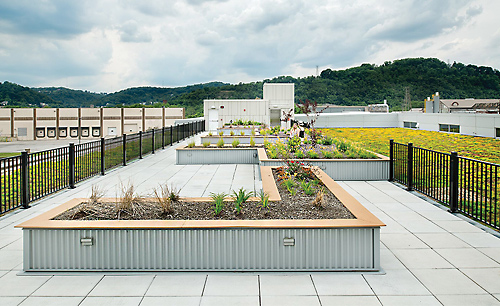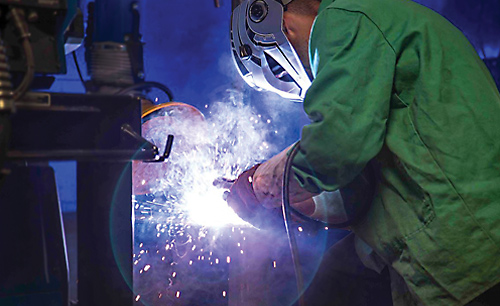But as employee count and production capacity grow, companies will need more space to expand, more senior employees will want to have their own offices, and employees starting families will consider moving to the suburbs for larger houses and better schools. Finding additional space within a city that’s convenient, affordable, and accommodating of these specifications is difficult to come by, but it presents an opportunity to owners and real estate developers in urban fringe communities and beyond to draw a maturing workforce to their properties.
Maintaining a “Vibe”
While shifting needs will help make companies and their employees more open to the move, it doesn’t change the fact that they have become accustomed to working in a central business district-like atmosphere. Property owners and developers who want to capitalize on this opportunity need to think about how they can make the move more palatable for companies with employees who have “grown up” in a vibrant urban environment. What will potential tenants see as positive features? Or drawbacks?
Central business districts have a “vibe” the maturing workforce will be reluctant to lose for what they might consider a more sterile, remote environment. This naturally occurring energy is difficult to define, but the feeling of vitality and connectedness it engenders is a crucial asset to both communities and workplaces.
Although “vibe” is harder to come by in areas outside central business districts, it is not impossible to find or cultivate. Urban fringe communities often have an established “sense of place” — a walkable older business district with buildings that have good bones and housing stock that’s ripe for rehabbing into trendier space.
Brand image, as well as budget, weighs heavily on location decisions. Companies want space and a surrounding community that fits their workplace cultural identity. If the location doesn’t appeal to the talent a company is trying to attract, chances are the property will be passed over for one with more spark. For employees and potential employees, coming to work in a creative, amenities-rich environment is important, but it’s not all they care about. They also want to come to work in a neighborhood that makes them feel welcome, safe, and at home. How the surrounding community receives them, the atmosphere and identity it conveys, and their subsequent sense of belonging are all felt acutely by employees.
What’s near a property — such as restaurants, other businesses, and support services — can be as important as the property itself. Employees want to be able to easily and comfortably go out for coffee breaks, take clients out to lunch or get drinks with co-workers and friends after work. If they can’t do those things, that’s an immediate strike against the property.

While economically depressed, urban fringe neighborhoods are challenging to develop and market, they are also full of potential when the community has made a commitment to their revitalization. Owners and developers in such communities who attract new industry; establish a new economic pillar; rehab blighted, vacant properties, and put them back on the tax rolls will be lauded as catalysts for renewal. Even if nearby blight evokes negative images, potential tenants will take a chance on a property if it is a unique, interesting space, relatively inexpensive, and they are confident in the trajectory of local revitalization efforts.
While shifting needs will help make companies and their employees more open to the move, it doesn’t change the fact that they have become accustomed to working in a central business district-like atmosphere. Such an investment in a community’s turnaround can be mutually rewarding in the long run. As a case in point, the Pittsburgh neighborhood of Lawrenceville was “once a blue-collar neighborhood more down-and-out than up-and-coming,” according to Pittsburgh Magazine. The burgeoning new robotics industry in that area has not only put the industrial/residential community back on the map, it has also paved the way for its distinction as one of the hottest neighborhoods in the city. The redevelopment of old, obsolete industrial sites provided homes for this new industry and lit the match that sparked its renewal and economic upturn.
Suburban Amenities
Blight is often less of an issue for more suburban communities — neighborhoods that are a little further out from the central business district and urban fringe. Potential tenants and their employees are sometimes leery of these locations because they may feel sterile in appearance or isolated. Property owners and developers need to focus on creating community-connected properties and build a high level of amenities into the property to make it feel less like a product of urban sprawl. A unique property will make it more appealing to a maturing urban workforce.
- Attractive high-level on-site amenities may include:
- Green spaces and picnic areas
- Rooftop patios
- Skylights to let in natural light
- Fitness amenities
- Indoor parking
- Bicycle- and pedestrian-friendly roads and paths
While economically depressed, urban fringe neighborhoods are challenging to develop and market, they are also full of potential when the community has made a commitment to their revitalization. Employees don’t want long, heavily trafficked daily commutes. Properties located on routes that are easily accessible by public transportation or car will have an advantage. In cases where buses and light rails are inconvenient to use or not readily available, which can sometimes be the case outside central business districts and urban fringe communities, there needs to be nearby residential areas with diverse housing options.
Apartments and condos may be preferred by young, single employees, but a maturing workforce that’s starting families will likely be more interested in buying a house. In either case, companies being able to offer their employees the option of living near where they work can be a major draw.
Quality of life, high-level amenities, and a rich sense of community are crucial elements to retaining a maturing workforce long-term. Companies cannot grow and flourish without talented employees. If a property cannot attract the workforce that a company strives to employ, and support its overall growth, it will fall out of the running rather quickly in the location decision-making process. Owners and developers marketing their properties to young and maturing companies need be cognizant of that if they want to succeed in drawing a maturing urban workforce to urban fringe communities and beyond.


